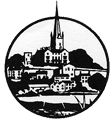Visit to Harvington Hall and the Dudmaston Estate (23rd September 2015)
The weather may have been very cloudy - though the rain held off until we got back to Ross - but the day was anything but dull. Thirty-two Ross DFAS members and guests enjoyed visits to two contrasting properties: Harvington Hall in, now in just 25 acres, with its long history marred by the post-Reformation persecution of Catholics; and Dudmaston an archetypal minor English country house of privilege and style, set in 3,000 acres.
Harvington Hall is a moated medieval and Elizabethan manor house near Kidderminster largely built in the 16th C by Humphrey Packington, who was renowned for his faith and his activities sheltering priests. The Hall passed into the Throckmorton family through marriage at the very end of the 17th C but was later allowed to deteriorate for some 200 years. It now belongs to the Roman Catholic Archdiocese of Birmingham to which it was gifted in 1923 and which has since undertaken extensive restoration, still continuing.
Split into two groups after coffee, the party had fascinating, if a little long-winded, guided tours of the house with its disguised rooms of worship and its multitude of priest holes, thought to be the work of Nicholas Owen, a noted and cunning builder employed by Packington. The result is a rabbit-warren of a building with floors at varying levels, secret panels, false ceilings and chimneys, carefully crafted staircases and hardly a right-angle throughout. This was to defeat the ruffian gangs of searchers ("pursuivants") with their probes and measuring rods, who would be rewarded by the authorities - by results. The harsh overall impression of those times left the party with food for thought.
Moving on towards Bridgnorth the first activity at Dudmaston was a by then very welcome buffet lunch at about 1.45. Next there was an informative introduction to the house and its history from a National Trust volunteer. Originally a fort set up in Norman times to keep the Welsh in Wales, part of the present building is Tudor in origin, the large Georgian house having been added in the late 17th C and extended in the 18th C. In the last 700 years of its history it has never been sold; the property mainly passing through the female line of the Wolryche/Whitmore family.
The then descendant, Lady Rachel Labouchère, made a lasting arrangement in 1978 with the National Trust for the property to be managed by the Trust, but for it to be occupied by the family, now the Hamilton-Russells. The tour of the house confirmed that it has a distinctly "family" feel; very elegant and with a wealth of paintings, chandeliers and other artefacts - but lived-in.
In late afternoon, after seeing the house and the separate art gallery, fatigue began to set in and many of the party were more intent on cups of tea than visiting the fine gardens above the large lake or exploring the extensive woodland.
Philip Blunden

